Quick Look
Grade Level: 7 (6-8)
Time Required: 1 hour
Expendable Cost/Group: US $5.00
Group Size: 5
Activity Dependency: None
Associated Informal Learning Activity: Yogurt Cup Speakers
Subject Areas: Physical Science, Problem Solving, Reasoning and Proof, Science and Technology
NGSS Performance Expectations:

| MS-PS2-3 |
| MS-PS2-5 |
Summary
Students are introduced to the role of electricity and magnetism as they build speakers. They also explore the properties of magnets, create electromagnets, and determine the directions of magnetic fields. They conduct a scientific experiment and show cause-effect relationships by monitoring changes in the speaker's movement as the amount or the direction of the current change.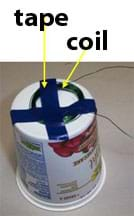
Engineering Connection
The study of electromagnetism is the foundation of electrical engineering. In addition, it finds wide application in other engineering disciplines. For example, electromagnets are essential to the design of electric generators and electric motors and therefore to the work of mechanical engineers. They are also used by aerospace engineers as electromagnetic propulsion systems can provide moving power for spacecraft.
Learning Objectives
After this activity, students should be able to:
- Create an electromagnetic field by running current through a wire coil.
- Explain that electric currents produce magnetic fields. The stronger the current, the more intense the magnetic field.
- Explain how electricity and magnetism are related concepts.
- Describe properties and characteristics of magnets:
- Magnets can be permanent or temporary.
- Magnets and electromagnets attract or repel each other; similar poles repel, while dissimilar poles attract.
- Magnets and electromagnets attract or repel another objects.
- Magnets and electromagnets exert forces at a distance through magnetic fields.
Educational Standards
Each TeachEngineering lesson or activity is correlated to one or more K-12 science,
technology, engineering or math (STEM) educational standards.
All 100,000+ K-12 STEM standards covered in TeachEngineering are collected, maintained and packaged by the Achievement Standards Network (ASN),
a project of D2L (www.achievementstandards.org).
In the ASN, standards are hierarchically structured: first by source; e.g., by state; within source by type; e.g., science or mathematics;
within type by subtype, then by grade, etc.
Each TeachEngineering lesson or activity is correlated to one or more K-12 science, technology, engineering or math (STEM) educational standards.
All 100,000+ K-12 STEM standards covered in TeachEngineering are collected, maintained and packaged by the Achievement Standards Network (ASN), a project of D2L (www.achievementstandards.org).
In the ASN, standards are hierarchically structured: first by source; e.g., by state; within source by type; e.g., science or mathematics; within type by subtype, then by grade, etc.
NGSS: Next Generation Science Standards - Science
| NGSS Performance Expectation | ||
|---|---|---|
|
MS-PS2-3. Ask questions about data to determine the factors that affect the strength of electric and magnetic forces. (Grades 6 - 8) Do you agree with this alignment? |
||
| Click to view other curriculum aligned to this Performance Expectation | ||
| This activity focuses on the following Three Dimensional Learning aspects of NGSS: | ||
| Science & Engineering Practices | Disciplinary Core Ideas | Crosscutting Concepts |
| Ask questions that can be investigated within the scope of the classroom, outdoor environment, and museums and other public facilities with available resources and, when appropriate, frame a hypothesis based on observations and scientific principles. Alignment agreement: | Electric and magnetic (electromagnetic) forces can be attractive or repulsive, and their sizes depend on the magnitudes of the charges, currents, or magnetic strengths involved and on the distances between the interacting objects. Alignment agreement: | Cause and effect relationships may be used to predict phenomena in natural or designed systems. Alignment agreement: |
| NGSS Performance Expectation | ||
|---|---|---|
|
MS-PS2-5. Conduct an investigation and evaluate the experimental design to provide evidence that fields exist between objects exerting forces on each other even though the objects are not in contact. (Grades 6 - 8) Do you agree with this alignment? |
||
| Click to view other curriculum aligned to this Performance Expectation | ||
| This activity focuses on the following Three Dimensional Learning aspects of NGSS: | ||
| Science & Engineering Practices | Disciplinary Core Ideas | Crosscutting Concepts |
| Conduct an investigation and evaluate the experimental design to produce data to serve as the basis for evidence that can meet the goals of the investigation. Alignment agreement: | Forces that act at a distance (electric, magnetic, and gravitational) can be explained by fields that extend through space and can be mapped by their effect on a test object (a charged object, or a ball, respectively). Alignment agreement: | Cause and effect relationships may be used to predict phenomena in natural or designed systems. Alignment agreement: |
International Technology and Engineering Educators Association - Technology
-
Explain how knowledge gained from other content areas affects the development of technological products and systems.
(Grades
6 -
8)
More Details
Do you agree with this alignment?
State Standards
American Association for the Advancement of Science - Science
-
Energy can be transferred from one system to another (or from a system to its environment) in different ways: 1) thermally, when a warmer object is in contact with a cooler one; 2) mechanically, when two objects push or pull on each other over a distance; 3) electrically, when an electrical source such as a battery or generator is connected in a complete circuit to an electrical device; or 4) by electromagnetic waves.
(Grades
6 -
8)
More Details
Do you agree with this alignment?
-
Energy appears in different forms and can be transformed within a system. Motion energy is associated with the speed of an object. Thermal energy is associated with the temperature of an object. Gravitational energy is associated with the height of an object above a reference point. Elastic energy is associated with the stretching or compressing of an elastic object. Chemical energy is associated with the composition of a substance. Electrical energy is associated with an electric current in a circuit. Light energy is associated with the frequency of electromagnetic waves.
(Grades
6 -
8)
More Details
Do you agree with this alignment?
-
As energy spreads out, whether by conduction, convection, or radiation, the total amount of energy stays the same. However, since it is spread out, less can be done with it.
(Grades
9 -
12)
More Details
Do you agree with this alignment?
Materials List
Each group needs:
- 2 round magnets (½ to ¾ inch diameter)
- 15 ft, 20-24 gauge coil wire (enamel-coated transformer coil wire)
- plastic container, (such as from yogurt, whip topping, butter
- D-cell battery
- sandpaper
- electrical tape
To share with the entire class:
- radio with detachable speakers and output of at least 20 watts
Pre-Req Knowledge
Students should know how to:
- Make a series circuit.
- Identify the north and south poles of a magnet.
Introduction/Motivation
Can you imagine life without radios? Do you know that the object that makes the speaker in the radio work is an electromagnet? An electromagnet is created with a battery (or some other source of electricity) and a wire. A battery has two ends, positive and negative. Although electrons collect at the negative end of the battery, they can flow to the positive end through a wire. The flowing electrons generate a magnetic field. The magnetic field from one wire is quite small. By putting many wires next to each other, a much larger field is created. The easiest way to do this is by making the wire into a coil with many loops. The idea behind an electromagnet in a speaker is simple: by running electric current through a wire coil, you can create a magnetic field. The field from the electromagnet is attracted or repelled from the field of a permanent magnet in the center of the speaker. When the current in the coil changes, so does the strength of the magnetic field. When the strength of the magnetic field changes, the attractive force between the coil and the permanent magnet changes. The changing force makes the speaker vibrate and produce sound. The bigger the vibrations, the louder the sound. Electromagnets are also used inside televisions to generate pictures, in electric motors, and in some medical devices.
Now that you know some applications of electromagnets, can you say what the difference between a regular magnet and an electromagnet is? A magnet is any material that has a magnetic field. With a regular magnet, the magnetic field is permanent or "always on." However, with an electromagnet, only when electrical current is flowing through the wire coil is there a magnetic field. This property makes electromagnets more useful than permanent magnets in many applications. For example, a big electromagnet on the end of a crane can lift and drop large masses of iron such as junk cars in a scrap yard. Three factors that increase the strength of an electromagnet are: 1) increasing the current flowing through the coil, 2) increasing the number of coils, and 3) putting an iron core inside the coil.
Procedure
Background
How can the direction of the magnetic field of an electromagnet be determined? Similar poles on magnets repel, while dissimilar poles attract. Running current through wire creates a magnetic field similar to a field of a magnet. That field's direction and magnitude depend on the magnitude of the current and the direction of the current. The direction of the magnetic field can be determined by using the right hand rule:
Place the wire in your hand with your thumb in the direction of the current [point your thumb from positive (+) to negative (-)]. Close your hand so that your fingers wrap around the wire. Your fingers are pointing in the direction of the magnetic field lines.
How do speakers work? A sound is produced when a vibrating object moves the air particles around it, which in turn move the air particles around them. Our ears pick up these fluctuations in air pressure and translate them into signals the brain can process. A speaker takes the electrical signal and translates it back into physical vibrations to create sound waves. Traditional speakers do this with a driver. The driver includes a permanent magnet and an electromagnet called a voice coil. The driver produces sound waves by rapidly vibrating a flexible cone that is connected to the voice coil. The voice coil is a basic electromagnet. This electromagnet is under the influence of a constant magnetic field created by a permanent magnet. These two magnets interact with each other in the usual way: The positive end of the electromagnet is attracted to the negative pole of the permanent magnet and repelled by its positive pole. A stereo signal constantly reverses the flow of electricity, switching the north and south ends of the electromagnet. In this way, the alternating current constantly reverses the magnetic forces between the voice coil and the permanent magnet rapidly pushing the coil back and forth. When the coil moves, it pushes and pulls on the speaker cone. This vibrates the air around the speaker and creates sound waves.
Before the Activity
- Set out pairs of magnets at each table.
- Briefly review magnets and their polarities.
- (optional) Bring out a speaker radio and have it playing some music.
With the Students
- When students enter, have them explore, if they have not already started on their own, the effects the magnets have on each other when similar poles are near each other (such as either north to north or south to south). Notice the effects the magnets have on each other when dissimilar poles are near each other (such as either north to south or south to north).
- Distribute the remaining supplies. Have students create electromagnets by winding roughly 6 to 15 feet of wire around a cylindrical object such as a C- or D-cell battery (see Figure 1). Leave two inches of wire hanging off at each end.
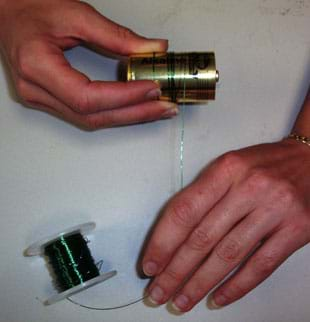
- While keeping the wire in the shape of a coil, carefully remove the wire from the cylindrical object and tape the coil so it does not unravel.
- Rub a piece of sandpaper on each free wire end to remove the enamel insulation. Remove about 1 inch of insulation from each end.
- Hold the ends of the wire to opposite ends of the battery to make a series circuit with the battery and the coil. Move the coil close to the magnet and observe its motion. Hook the battery up differently and see what happens to the magnets. (When the coil is connected to the battery in one way, one side of the coil is the north pole and the other side is the south pole of the electromagnet. The north pole of the electromagnet will be attracted to the south pole of the permanent magnet. When the battery is turned around, the poles of the electromagnet are reversed.)
- Attach the coil and a permanent magnet to the bottom of the container with either tape or hot glue. Attach the coil and magnet in such a way that the coil and magnet are next to each other. There are many different creative ways to do this that will work. Examples are shown in Figures 2 and 3.
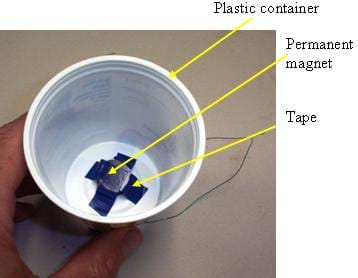
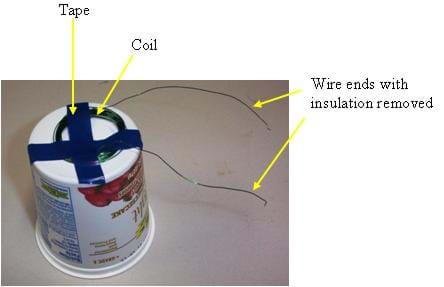
- Connect the ends of the speaker wire to the speaker output of the radio. On the back of the radio, look for plugs to connect the speaker wires to. These are usually holes that the wires are pushed into. Choose the plugs for one speaker (the left, for example) and insert one end of the wire from the yogurt speaker into one hole, and the other end of the wire into the other (see Figure 4).
- Turn the radio on and adjust the volume. When more current flows through the wire coil, the electromagnetic force increases. As the radio changes the current very fast, the changing electromagnetic force causes the plastic cap to vibrate. The vibration creates sound waves in the air, which are heard.
- The wires of the speaker may get hot. When electric current flows through the wire, some of the electrical energy is converted to heat energy due to the résistance inside the wire. If you touch the wire, the heat will transfer to your skin. When the volume of the radio is turned up, more electricity flows through the wire and more heat is generated. If the speaker gets too hot, turn down the volume.
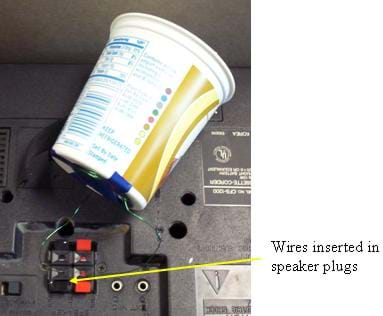
Vocabulary/Definitions
current: A flow of electrical charge carriers. The common symbol for current is the uppercase letter I. The standard unit is the ampere symbolized by A.
electromagnet: A magnet consisting of a coil of insulated wire wrapped around a soft iron core that is magnetized only when current flows through the wire.
magnet: An object that is surrounded by a magnetic field and has the property of attracting iron, steel, or other magnets.
magnetic field: A region in which magnetic forces can be observed.
magnetic force: The force exerted between magnetic poles or between two electrically charged moving particles (protons and electrons).
Assessment
Pre-Activity Assessment
Discussion Questions: Solicit, integrate and summarize student responses:
- Can we make a non-magnetic object magnetic? (Answer: Yes, this is known as magnetic induction. This phenomenon can be demonstrated with two nails. We can magnetize one nail by touching it to a magnet. Then, both nails will hang together. The magnetized nail is a temporary magnet. Temporary magnets retain their magnetism for a short time. They are similar to electromagnets that magnetize where the electric current is on and demagnetize when it is off.)
- What is a magnetic field and where do magnetic fields come from? (Answer: Magnetic fields are caused by the movement of electrons. The magnetic field lines give the direction in which the magnetic force acts. They converge where the magnetic force is strong and spread out where it is weak. For instance, in a compact bar magnet, they spread out from one pole and converge towards the other. The magnetic force is strongest near the poles where these field lines come together. A space modified by the presence of magnetic field lines is a magnetic field.
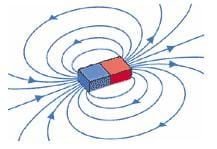
- Does magnetism ever wear off? (Answer: Most permanent magnets retain their magnetism for a very long period. This is because they are composed of electrons divided naturally into "magnetic domains"—tiny regions where all the magnetic fields of the atoms are all pointing in the same direction. These electrons are charged and spin, acting like little electromagnets, and their magnetism never wears off. It is the lining up of many, many electron spins that creates permanent magnets. Therefore, the underlying magnetism never wears off; only the ordering of all the spins together may become more disordered.)
Activity Embedded Assessment
Now try this!: Have students try the following extra investigations once they have completed their speakers.
- Change the amount of current by using more than one battery and monitor the changes in the speaker's movement.
- Change the direction of the current by changing the wire connections to the battery and monitor the change in the speaker's movement. Can you relate the current's change in direction or change in amplitude to the change in movement in the speaker?
- When the speaker is connected to the radio, change the volume or add more than one magnet. Can you explain why the speaker gets louder or softer? (Answer: When the radio volume is turned up, more electrical current flows through the wire. More current makes the electromagnet stronger. The stronger the electromagnet, the more it is attracted to the regular magnet on the speaker. This makes the vibrations of the speaker bigger and the speaker volume louder. Using more than one permanent magnet or a stronger one also increases the attraction to the electromagnet so that also increases the sound from the speaker.)
Post-Activity Assessment
Question/Answer: Ask the following questions and discuss as a class:
- How many different forms of energy are in the speaker circuit? (Answer: Four different forms of energy exist in the circuit: electrical, heat, magnetic, and mechanical or kinetic. If a battery were used instead of a stereo, that would provide chemical energy as well.)
- Is this circuit in series or parallel? (Answer: This is a series circuit, because there is only one path.)
- What poles are attracted or repelled? (Answer: Different poles are attracted; like poles are repelled.)
- Was a conductor, insulator or both used? (Answer: Both a conductor and an insulator were used: the wire is the conductor and the coating around the outside of the wire is the insulator.)
- How could you increase the strength of the speaker/electro-magnet? (Answer: By wrapping more loops or coils of the wire, by increasing the current in the circuit, or by doing both.)
Evaluation Rubric: In addition to the questions above, use the Table 1 rubric to determine the effectiveness of student work. The rubric provides criteria to evaluate students' understanding of the purpose of the experiment and the relationship between the variables, and their ability to develop hypotheses and make logical conclusions.
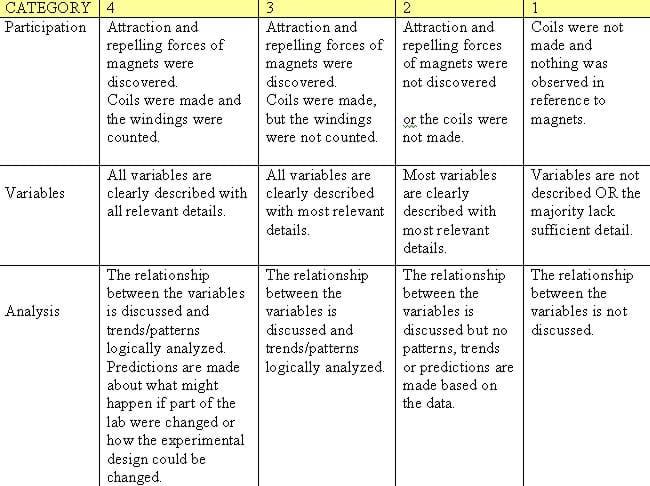
Safety Issues
The homemade speaker wires may get hot when they are attached to the radio. This is more likely to occur with very thin wires and very high-power radios that are set at a high volume.
Troubleshooting Tips
Make sure that students completely remove insulation from the wire ends or no current will flow.
Activity Extensions
Make another coil with more windings to wrap around the cell battery.
Dissect a real speaker and compare to the one created in this activity.
Observe the interaction between two electromagnets.
Connect multiple round magnets to the yogurt cup. (Expect the speaker to be louder.)
Have students save their homemade speakers and experiment with them in the Sound Visualization Stations activity (see station 3).
Activity Scaling
For upper grades, knowing that three variables influence these electromagnetic coils/speakers (current, number of coils and direction of current ), have students devise their own experiments to test each of the variable influences.
Subscribe
Get the inside scoop on all things TeachEngineering such as new site features, curriculum updates, video releases, and more by signing up for our newsletter!More Curriculum Like This

Students learn more about magnetism, and how magnetism and electricity are related in electromagnets. They learn the fundamentals about how simple electric motors and electromagnets work. Students also learn about hybrid gasoline-electric cars and their advantages over conventional gasoline-only-pow...

Students investigate the properties of magnets and how engineers use magnets in technology. Specifically, students learn about magnetic memory storage, which is the reading and writing of data information using magnets, such as in computer hard drives, zip disks and flash drives.

Students are briefly introduced to Maxwell's equations and their significance to phenomena associated with electricity and magnetism. Basic concepts such as current, electricity and field lines are covered and reinforced. Through multiple topics and activities, students see how electricity and magne...

Students induce EMF in a coil of wire using magnetic fields. Students review the cross product with respect to magnetic force and introduce magnetic flux, Faraday's law of Induction, Lenz's law, eddy currents, motional EMF and Induced EMF.
References
K-12 Electromagnetism and Magnetism. Knowledge Representation Laboratory. Accessed May 8, 2006. http://kr.cs.ait.ac.th/~radok/physics/k12.htm
Nolan, Lynne. Magnets, Electromagnets and Motors. Illinois Institute of Technology. Accessed May 8, 2006. http://www.iit.edu/~smile/ph9215.html
Brain, Marshall. How Electromagnets Work. HowStuffWorks. Accessed May 8, 2006. http://science.howstuffworks.com/electromagnet2.htm
Electromagnets. Schoolscience. Accessed July 7, 2006. http://www.schoolscience.co.uk/content/3/physics/copper/copch33pg1.html
Magnetism Wearing Off. The UIUC Physics Van Outreach Program. Accessed May 8, 2006. http://van.hep.uiuc.edu/van/qa/section/Electricity_and_Magnets/Magnets/20020408133732.htm
Harris, Tom. How Speakers Work. HowStuffWorks. Accessed July 7, 2006. http://electronics.howstuffworks.com/speaker.htm
Magnet. Wikipedia, the free encyclopedia. Accessed May 8, 2006. http://en.wikipedia.org/wiki/Magnet.
Copyright
© 2013 by Regents of the University of Colorado; original © 2005 University of South CarolinaContributors
Jed Lyons; Ivanka Todorova; Trevor RoebuckSupporting Program
GK-12 Program, Center for Engineering and Computing Education, College of Engineering and Information Technology, University of South CarolinaAcknowledgements
The contents of this digital library curriculum were developed under National Science Foundation GK-12 grant nos. DGE 0086427 and DGE 0440568. However, these contents do not necessarily represent the policies of the National Science Foundation, and you should not assume endorsement by the federal government.
Last modified: June 30, 2020









User Comments & Tips